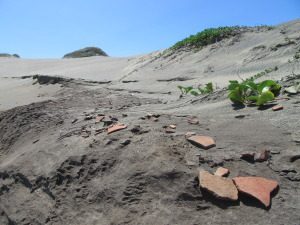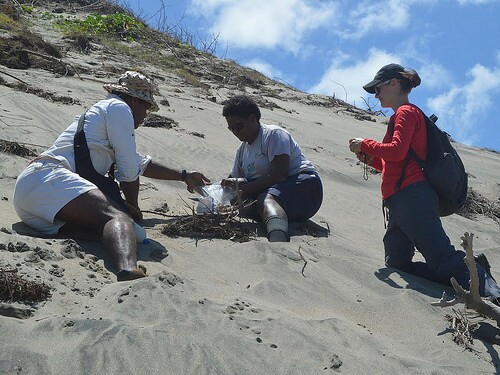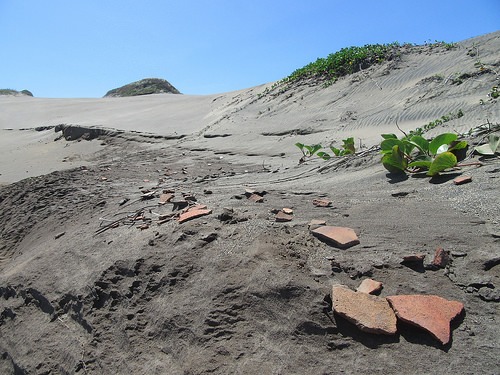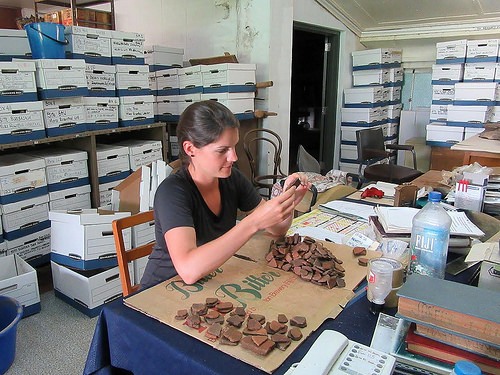
It was an unfortunate albeit serendipitous development for Dr. Kate Leonard, a young Canadian archaeologist who was due to fly into Fiji on February 20th, 2016. On that day, Winston, a category 5 cyclone, had arrived, wreaking devastation the Fiji islanders had never witnessed in their lifetimes, and hoped never to see again. Indeed, it was recorded as the most powerful cyclone to have ever impacted the southern hemisphere, and the second strongest on a global scale. Leonard saw herself stranded in Melbourne, Australia, waiting for the brunt of the storm to pass before she could continue on to her destination. Leonard’s pending departure was part of an ambitious global project she hatched to volunteer her knowledge and skills to work at no less than 12 projects in 12 countries in 12 months. Fiji was to be her third stop on her globe-trotting worldwide archaeology project, what she has called Global Archaeology: A Year of Digs. Now, after completing one month of work in Tasmania, she was looking forward to her newly assigned tasks with the Archaeology Department at the Fiji Museum in Suva on the island of Viti Levu, Fiji’s biggest island.
But after finally arriving on the 22nd, it didn’t take a rocket scientist to figure out that all her original plans for work on Fiji would be radically changed. As the Fiji Museum was a government organization, the devastation turned the plans and work schedule of the museum’s Archaeology Department on its head. Her initial flight across the country told the story.
“From the air it looked like giant hands had pressed down pockets of trees in the forests,” said Leonard. “There was flooding everywhere and the rivers had burst their banks. Once I reached Suva everything was uncertain. The electricity was still coming on and off and the country had been put into a state of emergency by the government. Many homes and livelihoods on the islands north of Viti Levu were lost and the death count a week after the cyclone approached 50.”
Due to the state of emergency all archaeology work would be focused on doing archaeological damage assessments. This meant that Leonard, in concert with a small team of museum archaeologists, would be traveling from Suva on the southeast coast of the island to Nadi on the western side. Along the way, they visited Bourewa, site of the earliest known settlement in Fiji (c. 3100 BP) and Momi Battery, a WWII gun emplacement site run by the National Trust of Fiji. Bourewa has yielded artifacts and features attributed to the Lapita, a Pacific Ocean people who thrived from c. 1600 BCE to c. 500 BCE. Archaeologists suggest that the Lapita is ancestral to the later cultures found in Polynesia, Micronesia, and some coastal areas of Melanesia.
“We also did a walk over of the amazing Sigatoka Sand Dunes, where we had to do an unanticipated rescue lift of two human skeletons,” she said. The effects of the cyclone had re-sculpted the dunes, erased much of the previous vegetation and deposited debris, including an excess of driftwood, along the shore. Along with that, the force of the cyclonic waves and wind had also dredged up human bones.
“The team divided to see if more bone could be found,” Leonard writes in her blog “One group stuck to the lower slope where a skull, arm bones, and some vertebrae and ribs had already fallen down the slope and were resting in a jumble; the other group trudged directly up the steep slope and found a pelvis, ribs and vertebrae exposed to the elements. Once the sand was removed we found that there were actually two sets of legs lined up together! The force of the winds from Cyclone Winston had removed much of the sand covering the burials and the upper halves had fallen down the slope. Their location high up on the dune, above the latest dated occupation layer, tells us that the burials likely date to after 280 AD. If we had not lifted them that day all evidence of them being there would have been lost, but now they will be kept in the Fiji Museum for analysis. This was rescue archaeology to the extreme!”*
Human occupation at Sigatoka has been dated from the earliest settlement period of Fiji to the historic period. Archaeologists have determined occupation here through at least six different episodes, creating a layer-cake physical record observed on some of the coastal slopes. In addition to human remains, the team took note of pottery fragments, evidence of a sea salt drying operation. Dated to 420 – 660 A.D., they were once part of large trays, about 60 cm in diameter. “On the back of some of the fragments you can see the impressions of mats and leaves,” explains Leonard in her blog. “This small clue helps to paint a picture of how the trays were made of thick slabs of wet clay pressed onto mats or beds of leaves. These large shallow trays would have been filled with sea water, left in the sun to evaporate, and then the sea salt collected for use and maybe trade.”
__________________________________________
Discovering the bone exposed high up on the sand slope. Image courtesy Fiji Museum
________________________________________________________
Fragments of ceramic salt drying trays. Image courtesy Kate Leonard and the Fiji Museum
________________________________________________________
Kate Leonard in the lab. Image courtesy Kate Leonard and the Fiji Museum
______________________________________________
Popular Archaeology asked Leonard what she thought was unique about doing archaeology work in Fiji.
“The pace of work is very different from what I am accustomed to as a North American,” she responded. “There are certain protocols and sequences of interaction that must be followed in order to be considered polite.” For example, she continues, “When archaeologists go out into the field to conduct work they must first visit the village associated with the land/archaeological site they are interested in and participate in a sevusevu. This is a ceremony whereby kava (a mildly narcotic powdered root made into a drink) is exchanged and consumed. The ceremony not only allows for the exchange of information regarding where all the parties are from, their chiefly affiliations and what work they wish to conduct, but it is a way of showing respect. It is a great transgression to go onto community land without conducting the sevusevu.”
For Leonard, the diversity and abundance of archaeological sites on Fiji has been an eye-opener. Yet, Leonard adds, “since there have not been many archaeological investigations here, there is still so much to discover and discuss.”
Popular Archaeology will be following and reporting on Leonard’s worldwide experiences periodically throughout 2016 as she hops from one location to another during her global journey. To continue the work, however, Leonard will need financial support from donors. Readers interested in reading about and supporting her self-directed Global Archaeology crowdfunded project can learn more at gofundme.com/globalarchaeology.
_________________________________________________________
*”Sigatoka Sand Dunes: Rescue archaeology in Fiji,” Global Archaeology blog, Dr. Kate Leonard.
_________________________________________________________

______________________________________________
Travel and learn with Far Horizons.
____________________________________________
This richly illustrated issue includes the following stories: Recent findings shedding new light on the whereabouts of the remains of Philip of Macedon, father of Alexander the Great; how an archaeologist-sculptor is bringing bones of the dead back to life; archaeologists uncovering town life at the dawn of civilization; an exclusive interview with internationally acclaimed archaeologist James M. Adovasio about what makes the Meadowcroft Rockshelter prominent in the ongoing search for the first Americans; what archaeologists are finding at the site of the ancient city of Gath, the home town of the biblical Philistine giant, Goliath; and how scientists are redrawing the picture of human evolution in Europe. Find it on Amazon.com.










